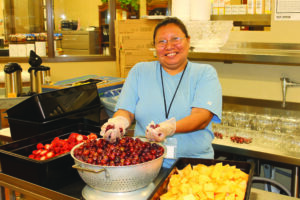By SCOTT MCKIE B.P.
ONE FEATHER STAFF
It was 10am on a typical Monday and the buzz of workers prepping food in the Cherokee Central Schools kitchen was palpable. Food service workers were busy cutting fresh fruit and vegetables and preparing healthy meals for the 1,100 students that they serve daily.

Cecelia “Prescious” Maney and Natalie Bradley, kindergarten students at Cherokee Elementary School, enjoy their healthy lunches on Monday, Aug. 13. (SCOTT MCKIE B.P./One Feather photos)
This year, however, the menu is a little different.
Changes are being phased in as a result of the Healthy, Hunger-Free Kids Act (HHFKA), a federal law which marks the first changes to school nutrition in over 15 years.
“This is a national change,” said Laura Cabe, child nutrition director at Cherokee Central Schools. “It’s taken time. We’ve had all the training, but it has taken time to get it out in the community.”
“We are here, number one, for the kids, to feed the kids and educate the families and the students,” she said.
Some of the changes have already hit home for some students. Under the current guidelines, perennial favorite peanut butter and jelly sandwiches are gone. “Every student must have a fruit and/or vegetable on their tray.”
The changes, at outlined in the HHFKA, will be implemented over a three-year period. According to the USDA, some of the changes to the National School Lunch Program (NSLP) include: daily serving of fruits and vegetables; a weekly requirement for dark green or red/orange vegetables, legumes, starchy and other vegetables; weekly meat plus a daily requirement; and a requirement that half of the offered grains during a week must be whole grains.
Along with the school lunch changes, another big change this year is the ban on fast foods. Trash cans located outside the school are emblazoned with signs stating “Fast Food Stops Here!!!”
Cherokee Central Schools has developed a “Stop Light Guide for Healthy Eating” in which foods are categorized as follows:
– Green foods or go foods “are low in ‘bad’ saturated and trans fat and calories, but are packed full of nutrients”; examples include – fresh fruits and vegetables, skim milk, baked chicken, dried beans
– Yellow foods or slow foods are “higher in ‘bad’ fat, added sugar and/or calories, but still have some nutrients”; examples include – juice, white pasta, 2 percent milk, peanut butter
– Red foods or whoa foods “should only be eaten once in a while”; examples include: soft drinks, candy, chips, French fries, fry bread
Cherokee Elementary School has received a USDA Fresh Fruit and Vegetable grant that will help provide fresh fruits and vegetables to students as healthy snacks. “Not only will this help with students being hungry either before or after lunch,” said Cabe, “it will help them to understand where their food comes from, how it grows, and how it’s prepared.”

Salina Lee, Cherokee Central Schools food service worker, smiles as she preps fresh fruits for Monday’s lunch service.
“It’s just going to be very exciting for the kids to see what a star fruit is, how it tastes, how a mango tastes.”
Christine Bradley, a Cherokee Central Schools food service worker from the Birdtown Community, will be administering the grant.
“As a parent, I think it’s great that we’re having to do these changes,” said the mother of three. “I have a daughter in fifth grade and she loves it. She thinks it’s great because she’s very health conscious.”
Bradley said that education about proper nutrition and food choices must extend to the home as well. “You’ll have parents that will come in and bark, ‘You’re not feeding my kid enough’. But, really, our kids eat too much. Go to McDonald’s and it’s around 1,500 calories for one meal, and it’s not good. Parents need to take more responsibility about what their kids eat.”
Yona Wade, Cherokee Central Schools public relations director, jokingly said that we all grew up on pizza and corn. That combination is now gone, and in its place is a pizza, romaine salad with light dressing, baby carrots and watermelon.
“We have no fryers,” he said. “Everything is baked, broiled or steamed.”
Some are not on board with the changes, and Wade related, “We have no rule against students packing their lunch.
However, he relate that the school’s budget funds the Universal Food Program. “If they live on the Boundary and come to our school, they get a free lunch under the program.”
Wade said providing nutrition education to the students is just as important as providing healthy meals because it is knowledge they can take with them through life.
Cabe said her main goal is to be visible in the cafeteria and get feedback from the students. “We’ve got to work together on this…I want the kids to know, when they leave here, what it means to have a well-balanced diet. The way our plates look now with fresh fruits and vegetables and whole grains is just inspirational.”






